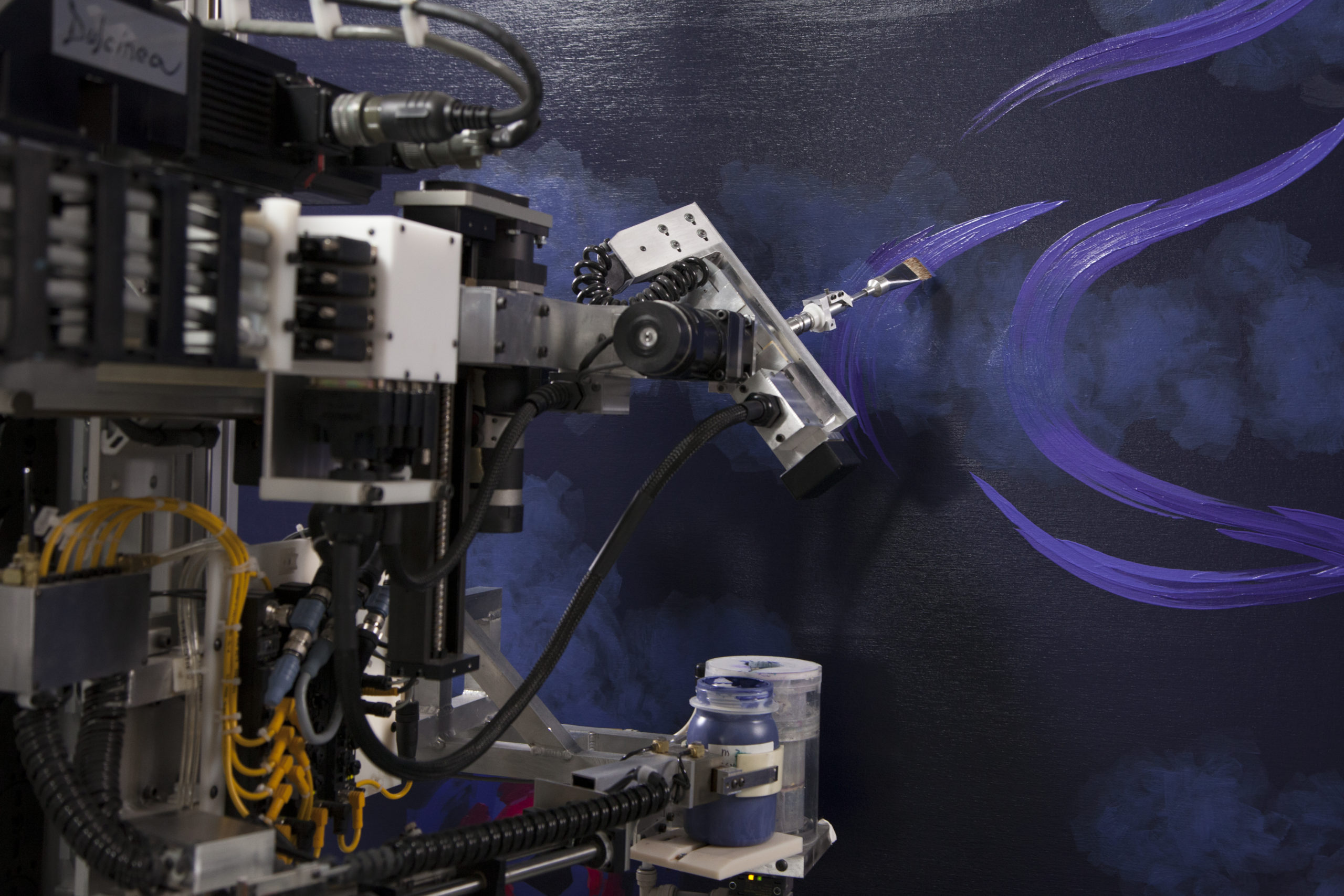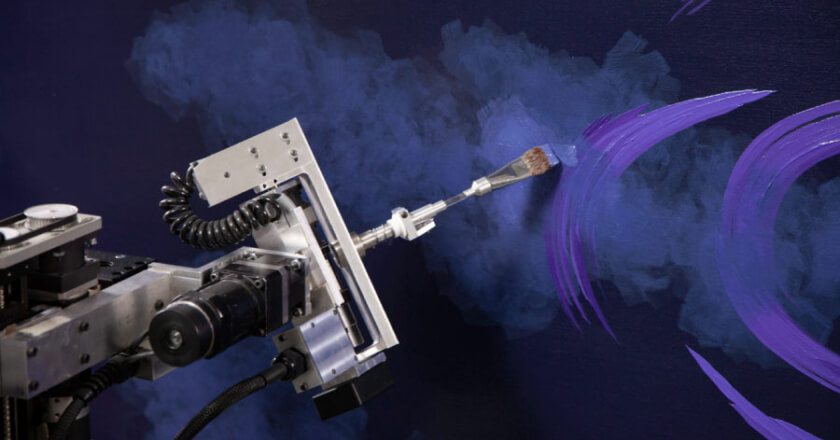Get Inspired
Build the life you love. Learn more about fusioneering:

Posted on May 13, 2022 in AI Painter
Her name is Dulcinea. She’s an autonomous robot that makes large, impressive paintings from Paul Kirby’s inspirations and AI tools. It’s a dizzying, complicated, and fascinating process. Maybe you’re wondering… Just how do Paul Kirby and Dulcinea make a painting?
Before any great work of art is made, it must first enter the world as an idea. There’s no limit to where these ideas can be born from – swirling coffee, larval amphibians, Sherlock Holmes, and other great artists are just a scant few of the subjects that have inspired Dulcinea paintings. Paul asks himself, “What ideas excite me for this next painting?”, “What challenges me?” It’s from these intersections of passion and pushing oneself that Paul’s best ideas come to life.
If Paul decides that an initial idea has the inherent potential to become a great painting, then that idea becomes more developed and distilled into a succinct, clearly defined concept. An artist’s job is to adequately express their vision, and a concept that isn’t clear to oneself can’t hope to be effectively communicated to others.
Once the artistic concept for a painting is distilled into a concise conceptual statement, the question for Paul becomes, “How do I create my vision within the computer, and then derive from that brushstrokes for Dulcinea to paint. Many of Dulcinea’s paintings evolved from complex AI simulations, with many utilizing various forms of complex adaptive systems, chaotic systems, or adaptive life forms of AI, along with swarming behavior and expert systems. For example, the 2013 painting, Cappuccino Fluid Dynamic, was created using a dynamic fluids simulator and fluids colliding and swirling around in a virtual fluid chamber.
For some paintings, AI agents – which Paul often refers to as “ants” – are made to interact with various objects and situations in a simulated world. The accumulated activities and results of these intelligent agents serves as Dulcinea’s “blueprint” – the data set that determines the brushstrokes the robot will then make. Some of Paul’s favorite aspects of his endeavors with Dulcinea are the emergent surprises that are born out of these intricate, “living” simulations.
What Paul enjoys most is creating something in software which itself creates something that will eventually become brushstrokes. With Cappuccino Fluid Dynamic, Paul built a fluid simulator chamber and injected flowing fluids that collided, creating swirling currents whose energy was then captured and later converted into swirling patterns of curving brushstrokes.
Once the simulation and AI coding begin taking shape, a new question is addressed: what colors will best capture the concept of the painting? A full color palette must be determined for each work. How are the colors to be organized and used, and what color background should they be laid over? This may seem like the easiest portion of the process, but color theory is no simple matter. Color is one of the most important aspects of a painted work, and even small changes in hue and chroma can have a huge impact on the final tone and emotion of a piece. Paul has a room dedicated to paints and color-mixing, and as you can imagine, he spends a lot of time experimenting with shades and perfecting every color.
Now that we have computation and colors underway, it’s time to develop the robotic brushwork. As Paul’s interest in Franz Kline’s work may reveal, Paul considers the brushstroke itself as the most powerful and important component of a painting. Paul refers to each brushstroke as a “note,” and when the computer simulations are converted into complicated brushstroke maps for Dulcinea to understand, each note carries a dense packet of information. For every brushstroke Dulcinea needs to know:
… and so, so, so much more. This information must be translated across multiple programming languages in order to move from the computer that made the simulation to Dulcinea’s robotic computing “brain.”
This is the phase where everything is pushed forward. Shrugging and claiming a piece “is good enough” is never considered. Every aspect of the work, through painstaking iteration, must be advanced. The brushwork is tested – then evolved. The colors are tested – then evolved. The composition and design of the piece is tested – then evolved. You get the idea. The evolution stage is a messy, trying journey of experimentation and discovery. Every aspect of the work is in a state of constant evaluation, with Paul always trying to find the techniques and route that will best capture that initial concept.
The secret to success? Iteration, persistence, and never settling for less. The above phase of the creative process is repeated, as needed, until a sufficiently moving work of art – one that honors the original idea for its existence – takes form.
After all these iterations and refinements, we arrive at a critical phase near the end of the road to creation. Now a process of “slow looking” is necessary – simply taking time to observe – as all aspects of the work on the canvas are considered. Paul asks, “Are we fulfilling the dream and aspirations first set out in the original concept? What’s not working? What needs more work, more tweaking?” Once all these questions are fully satisfied, Paul and Dulcinea are ready to produce the final version of the painting.
Now the painting can come to life. Dulcinea paints the final canvas. Once completed, she adds her own signature, and finally turns off her own power. Later, Paul will frame, hang, and light the completed work of art in his studio.
And that’s it, another work of science and art comes to completion. Art theory and computer science fuse to make something greater than the sum of their parts – something extraordinary.
And we’ve only just scratched the surface. Want the full story of Paul and Dulcinea? Watch the film (nominated for Best Short at the Vail and Portland Film Festivals) for an in-depth look at the powerful relationship between man, art, and machine.
You can follow the Kirby Foundation on Instagram, Facebook, and LinkedIn for exciting inspiration on-the-go, or join the mailing list to stay up-to-date with every amazing Dulcinea development.
Are you interested in hearing the complete story of Paul and Dulcinea? Watch the video (nominated for Best Short Film at the 2021 Vail and Portland Film Festivals) for more info.
Want to be the first to know about every exciting new project at the Kirby Foundation?
Join Our Mailing ListBuild the life you love. Learn more about fusioneering:
Why pick which passion you should follow? Fusioneering allows you to cultivate many interests into something innovative and revolutionary.

Meet Paul and explore how blending your interests can empower you to follow your enthusiasm and bring your passions to life.